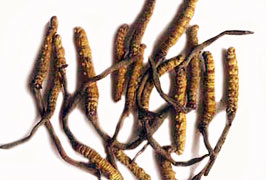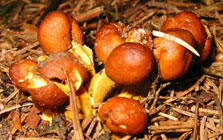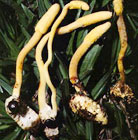| Cordyceps sinensis - Yartsa Goenbub in Bhutan |
| Highly
valued medicinal plant |
 |
Bhutan's Nature Yartsa Goenbub |
|
 |
Bhutan's Nature Yartsa Goenbub |
|
|
 |
| Chinese Cordyceps fungus (Cordyceps sinensis) - Yartsa Goenbub |
The Cordyceps is a rare species of fungus (mushroom) widely used both in clinical medicine and as
a household remedy. It is also considered potent at strengthening lung
and kidneys, increasing energy and vitality, stopping hemorrhage, decreasing
phlegm, and as an overall tonic.
The Cordycepssinensis, a combination of insect and plant remains inactive in
winter and comes out in summer. Of the two types, the black one is
more expensive than the white.
In
Bhutan Cordyceps (Cordyceps sinensis) locally called as "Yartsa
Goenbub" which is an insect parasite fungus having high commercial
demand as tonic/aphrodisiac.
In Nepal Cordyceps (Cordyceps sinensis) locally called as "Yarchagumba". Both names are derived from the Tibetan Yartsa gunbu, which means Summer grass winter-worm. Also the Chinese name dongchong xiacao is based on the original Tibetan name.
Cordyceps is found in subalpine
pasture lands of Nepal including Jumla and Dolpa area belonging
to Karnali zone. Yarchagumbais found on the high hills of
Dolpo and this is collected during the spring and early summer when the
snow melt and lichens sprout out on the hills.
Yartsa Goenbubis found at
14,000 feet (about 4,300m) and above. Wild Cordyceps sinensis is also found
in Tibetan Highlands of China and in Bhutan.
top
|
Medicine
uses |
 |
Cordecypes
sinensis is good for reinforcing the lung and kidneys, arresting bleeding
and dispelling phlegm. It is taken for shortness of breath, asthma, impotency,
emission, soreness of loins and knees, dizziness and tinnitus.
Actions: Adaptogen, tonic, immune stimulant, restorative.
 |
|
Cordyceps
sinensis
|
|
Caterpillar
fungus or Winter Worm - Summer Grass, those are the common names used
for the highly prized Chinese tonic herb Cordyceps, which gained national
publicity in mainstream publications a few years back because of its use
by Chinese women athletes engaged in breaking world running records. In
ancient China this fungus was used exclusively in the Emperor's Palace
because of its scarcity. Approximately 5 grams were stuffed into the stomach
of a duck and roasted until well cooked, then the Cordyceps was removed
and the duck was slowly eaten, twice daily over a period of 8-10 days,
this was thought to be as potent as 50 grams of Panax Ginseng. |
The
New York Journal of Medicine reported that Cordyceps has properties
similar to Ginseng, being used to strengthen the body after exhaustion
or long term illness. It has traditionally been used for impotence, backache,
to increase sperm production and to increase blood production. In China,
Cordyceps is used medically to regulate and support the gonads and as a
lung and kidney tonic. It is used specifically for excess tiredness,
chronic cough and asthma, impotence, debility, anemia, to build the bone
marrow and reduce excess phlegm.
 |
|
Cordyceps
family
|
|
 |
It
was either ground into a powder, or mixed with other tonics. |
 |
Today
the most popular recipe for caterpillar fungus is to stuff a duck with
the infected moth pupae, then boil it. |
 |
The
soup broth is then administered to patients. |
|
top
|
How
Cordyceps sinensis or Yartsa Goenbub is growing |
 |

|
|
Cordyceps
family
|
|
The
fungus, Cordyceps sinensis, grows on dead caterpillars of the moth Hepilus
fabricius.
 |
Spores
of Cordyceps sinensis grow inside the caterpillars filling the caterpillar
with filaments (hyphae). |
 |
When
the caterpillar dies the fungus produces a stalked fruiting body that produces
spores. |
 |
The
spores are spread in the wind to the next generation of caterpillars. |
|
top
| Information on Bhutan |
 |
| Links |
 |
 |
 |
External
links |
| Articles written by Daniel Winkler |
|
 |
top
|
 |
| Please
take notice that RAOnline is not involved
in the business with Cordyceps sinensis products. |
|
|
|





